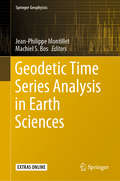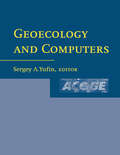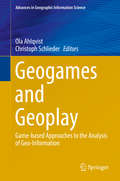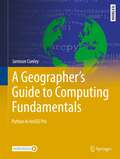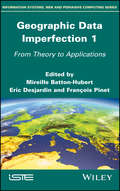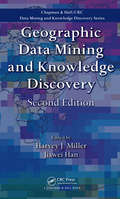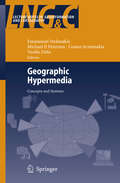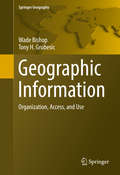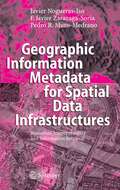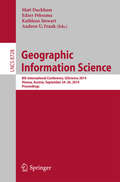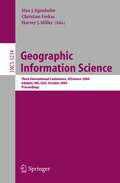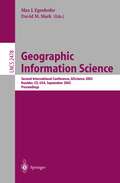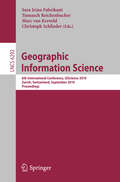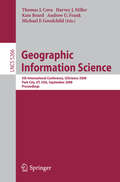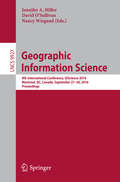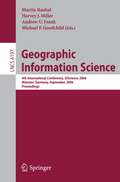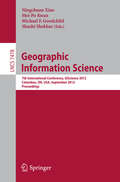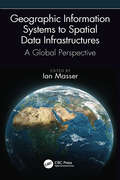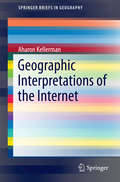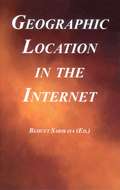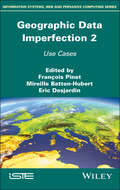- Table View
- List View
Geodetic Time Series Analysis in Earth Sciences (Springer Geophysics)
by Jean-Philippe Montillet Machiel S. BosThis book provides an essential appraisal of the recent advances in technologies, mathematical models and computational software used by those working with geodetic data. It explains the latest methods in processing and analyzing geodetic time series data from various space missions (i.e. GNSS, GRACE) and other technologies (i.e. tide gauges), using the most recent mathematical models. The book provides practical examples of how to apply these models to estimate seal level rise as well as rapid and evolving land motion changes due to gravity (ice sheet loss) and earthquakes respectively. It also provides a necessary overview of geodetic software and where to obtain them.
Geoecology and Computers
by Sergey A. YufinThis volume presents technical papers devoted to development and practical use of computer methods in geotechnical and geoenviromental engineering. It covers issues on space use and construction, soil and rock mechanics, and mining applications amongst other topics.
Geoecology and Computers
by SergeyA. YufinThis volume presents technical papers devoted to development and practical use of computer methods in geotechnical and geoenviromental engineering. It covers issues on space use and construction, soil and rock mechanics, and mining applications amongst other topics.
Geogames and Geoplay: Game-based Approaches to the Analysis of Geo-Information (Advances in Geographic Information Science)
by Ola Ahlqvist Christoph SchliederThis book brings together contributions from researchers, GIS professionals and game designers to provide a first overview of this highly interdisciplinary field. Its scope ranges from fundamentals about games and play, geographic information technologies, game design and culture, to current examples and forward looking analysis.Of interest to anyone interested in creating and using Geogames, this volume serves as a channel for sharing early experiences, discussing technological challenges and solutions, and outlines a future research agenda. Games and play are part of human life, and in many game activities, place, space and geography plays a central role in determining the rules and interactions that are characteristic of each game. Recent developments and widespread access to mobile information, communication, and geospatial technologies have spurred a flurry of developments, including many variations of gaming activities that are situated in, or otherwise connected to the real world.
A Geographer's Guide to Computing Fundamentals: Python in ArcGIS Pro (Springer Textbooks in Earth Sciences, Geography and Environment)
by Jamison ConleyThis upper-undergraduate textbook teaches students programming in GIS using a mix of computer science theory and hands-on activities, with the aim of empowering students to understand fundamentals and apply their knowledge beyond the specific examples in the book. Each of the book’s twenty-one chapters integrates instructional material with exercises in ArcGIS Pro. In doing so, this book combines the strengths of workbooks and theoretical textbooks to provide a holistic and comprehensive text. Each chapter concludes with an unguided task that ensures students have learned the broader principles explained therein. In addition to its unique format, the book covers oft-neglected topics such as debugging, creating a program from scratch, and managing metadata. Section I starts with the principles of scripting and programming with Python. Section II introduces the ArcPy module and elements specific to ArcGIS Pro. This section focuses on data structures, and how they are used and implemented within Python. Section III uses the topic of algorithms to guide the student through creating tools to add functionality to ArcGIS Pro. The last section, Section IV, builds upon section III to guide the student to developing and sharing projects and Python packages to include external open-source code and share the Python code as an open-source package. This text will prepare students for a long-term ability to do GIS programming, whether in industry or academic research. This comes from the author’s observations of students who have learned GIS programming in one platform, such as VBA in ArcMap, struggle to apply that knowledge to a new platform, such as Python in ArcGIS Pro, because the content was presented too closely with a specific platform. The integration of exercises with conceptual content, along with the choice of chapter content, serves this goal of preparing students for working in a dynamic, rapidly changing technology field.
Geographic Data Imperfection 1: From Theory to Applications
by Mireille Batton-Hubert Eric Desjardin François PinetGeomatics is a field of science that has been intimately intertwined with our daily lives for almost 30 years, to the point where we often forget all the challenges it entails. Who does not have a navigation application on their phone or regularly engage with geolocated data? What is more, in the coming decades, the accumulation of geo-referenced data is expected to increase significantly. This book focuses on the notion of the imperfection of geographic data, an important topic in geomatics. It is essential to be able to define and represent the imperfections that are encountered in geographical data. Ignoring these imperfections can lead to many risks, for example in the use of maps which may be rendered inaccurate. It is, therefore, essential to know how to model and treat the different categories of imperfection. A better awareness of these imperfections will improve the analysis and the use of this type of data.
Geographic Data Imperfection 1: From Theory to Applications
by Mireille Batton-Hubert François Pinet Eric DesjardinGeomatics is a field of science that has been intimately intertwined with our daily lives for almost 30 years, to the point where we often forget all the challenges it entails. Who does not have a navigation application on their phone or regularly engage with geolocated data? What is more, in the coming decades, the accumulation of geo-referenced data is expected to increase significantly. This book focuses on the notion of the imperfection of geographic data, an important topic in geomatics. It is essential to be able to define and represent the imperfections that are encountered in geographical data. Ignoring these imperfections can lead to many risks, for example in the use of maps which may be rendered inaccurate. It is, therefore, essential to know how to model and treat the different categories of imperfection. A better awareness of these imperfections will improve the analysis and the use of this type of data.
Geographic Data Mining and Knowledge Discovery
by Harvey J. Miller Jiawei HanThe Definitive Volume on Cutting-Edge Exploratory Analysis of Massive Spatial and Spatiotemporal DatabasesSince the publication of the first edition of Geographic Data Mining and Knowledge Discovery, new techniques for geographic data warehousing (GDW), spatial data mining, and geovisualization (GVis) have been developed. In addition, there has bee
Geographic Hypermedia: Concepts and Systems (Lecture Notes in Geoinformation and Cartography)
by Emmanuel Stefanakis Michael P. Peterson Costas Armenakis Vasilis DelisThe book serves as a collection of multi-disciplinary contributions related to Geographic Hypermedia and highlights the technological aspects of GIS. Specifically, it focuses on its database and database management system. The methodologies for modeling and handling geographic data are described. It presents the novel models, methods and tools applied in Spatial Decision Support paradigm.
Geographic Information: Organization, Access, and Use (Springer Geography)
by Wade Bishop Tony H. GrubesicThe history and future of geographic information (GI) in the context of big data creates new avenues of concern over its organization, access and use. In this book the authors explore both the background and present challenges facing the preservation of GI, focusing on the roles of librarians, archivists, data scientists, and other information professionals in the creation of GI records for its organization, access, and use.
Geographic Information Metadata for Spatial Data Infrastructures: Resources, Interoperability and Information Retrieval
by Javier Nogueras-Iso Francisco Javier Zarazaga-Soria Pedro R. Muro-MedranoMetadata play a fundamental role in both DLs and SDIs. Commonly defined as "structured data about data" or "data which describe attributes of a resource" or, more simply, "information about data", it is an essential requirement for locating and evaluating available data. Therefore, this book focuses on the study of different metadata aspects, which contribute to a more efficient use of DLs and SDIs. The three main issues addressed are: the management of nested collections of resources, the interoperability between metadata schemas, and the integration of information retrieval techniques to the discovery services of geographic data catalogs (contributing in this way to avoid metadata content heterogeneity).
Geographic Information Science: 8th International Conference, GIScience 2014, Vienna Austria, September 24-26, 2014, Proceedings (Lecture Notes in Computer Science #8728)
by Matt Duckham Edzer Pebesma Kathleen Stewart Andrew U. FrankThis book constitutes the refereed proceedings of the 8th International Conference on Geographic Information Science, GIScience 2014, held in Vienna, Austria in September 2014. The 23 full papers presented were carefully reviewed and selected from various submissions. The papers are organized in topical sections such as information visualization, spatial analysis, user-generated content, semantic models, wayfinding and navigation, spatial algorithms, and spatial relations.
Geographic Information Science: Third International Conference, GI Science 2004 Adelphi, MD, USA, October 20-23, 2004 Proceedings (Lecture Notes in Computer Science #3234)
by Max J. Egenhofer Christian Freksa Harvey J. MillerThis section gives a description of notions used throughout this study. Current achievements in developing action-centered ontologies are also discussed. 2.1 Ontologies In the context of information extraction and retrieval, different kinds of ontologies can be distinguished [15]: • Top-level ontologies describe very general concepts like space and time, not depending on a particular domain, • Domain ontologies and task ontologies describe the vocabulary related to a generic domain or kind of task, detailing the terms used in the top-level ontology, • Application ontologies describe the concepts that depend on the particular domain and task within a specific activity. Several investigations have been conducted to bring actions (tasks) to bear on - tologies. Among them are Chandrasekaran et al. [6] and Mizoguchi et al. [23] in the fields of AI and Knowledge Engineering. For the geospatial domain, Kuhn [21] and Raubal and Kuhn [26] have attempted to support human actions in ontologies for transportation. Acknowledging the importance of human actions in the geographic domain, a research workshop was held in 2002, bringing together experts from diff- ent disciplines to share the knowledge and work on this issue [1]. Camara [5], one of the workshop participants, has proposed that action-driven spatial ontologies are formed via category theory, for the case of emergency action plans.
Geographic Information Science: Second International Conference, GIScience 2002, Boulder, CO, USA, September 25-28, 2002. Proceedings (Lecture Notes in Computer Science #2478)
by Max J. Egenhofer David M. MarkGeographic Information Science: 6th International Conference, GIScience 2010, Zurich, Switzerland, September 14-17, 2010. Proceedings (Lecture Notes in Computer Science #6292)
by Sara Irina Fabrikant Tumasch Reichenbacher Marc Van Kreveld Christoph SchliederSince its inception in Savannah, Georgia (USA) in 2000, the highly successful GIScience conferenceseries (www.giscience.org)has regularlyattractedover250 researchers from all over the world whose common interest lies in advancing the research frontiers of fundamental aspects of the production, dissemination, and use of geographic information. The conference is bi-annual and brings together leading researchers from all cognate disciplines re?ecting the interdisciplinary breadth of GIScience, including (but not limited to) geography, cognitive s- ence, computer science, engineering, information science, mathematics, philo- phy, psychology, social science, and (geo)statistics. Following the, literally breathtaking,conference in Park City, Utah (USA) at 2103m, the sixth GIScience 2010 conference returned to Europe for the second time. The 2010 conference was held in Zurich, Switzerland, a place nominated repeatedly as the world’s most livable (if not cheapest!) city. Zurich is also a GIScience landmark, as in 1990 one of the founders of the GIScience conference series, Dr. Michael Goodchild, delivered a memorable talk setting out how f- damental research on GISystems could turn into GIScience at the very same conference location during the Spatial Data Handling Symposium.
Geographic Information Science: 5th International Conference, GIScience 2008, Park City, UT, USA, September 23-26, 2008, Proceedings (Lecture Notes in Computer Science #5266)
by Andrew U. Frank Michael Goodchild Thomas J. Cova Harvey J. Miller Kate BeardThe GIScience conference series was founded in 2000 with the goal of providing a forum for researchers interested in advancing the fundamental aspects of the prod- tion, dissemination, and use of geographic information. The conference is held bi- nually and attracts people from academia, industry, and government across a host of disciplines including cognitive science, computer science, engineering, geography, information science, mathematics, philosophy, psychology, social science, and stat- tics. Following a very successful conference in Münster, Germany in 2006, this year’s conference was held in Park City, Utah, USA, the prior site of the 2002 Winter Ol- pics and home to the annual Sundance Film Festival. There are two forms of submission to the conference: full papers of 6000 words or less and extended abstracts of 500-1000 words for either a presentation or poster. This format was originally designed to capture the cultural difference between researchers who prefer to publish a peer-reviewed conference paper and those who would rather submit an abstract covering work in progress. This year 77 full papers were submitted and reviewed by 3 Program Committee members, of which 24 were selected for pr- entation and inclusion in this volume. Of the 115 extended abstracts that were subm- ted and reviewed by 2 Program Committee members, 47 were accepted for an oral presentation and 25 were accepted for presentation as a poster. The abstracts were published in a second booklet and are available on the GIScience website (http://www. giscience. org).
Geographic Information Science: 9th International Conference, GIScience 2016, Montreal, QC, Canada, September 27-30, 2016, Proceedings (Lecture Notes in Computer Science #9927)
by Jennifer A. Miller David O’Sullivan Nancy WiegandThis book constitutes the refereed proceedings of the 9th International Conference on Geographic Information Science, GIScience 2016, held in Montreal, QC, Canada, in September 2016. The 21 full papers presented were carefully reviewed and selected from 63 submissions. The papers are organized in topical sections such as spatial algorithms; network analysis; spatial analysis; spatial methods; user-generated data and linked data; automated cartography and geovisualization.
Geographic Information Science: 4th International Conference, GIScience 2006, Münster, Germany, September 20-23, 2006, Proceedings (Lecture Notes in Computer Science #4197)
by Martin Raubal Harvey J. Miller Andrew U. Frank Michael F. GoochildThis book constitutes the refereed proceedings of the 4th International Conference on Geographic Information Science, GIScience 2006. The book presents 26 revised full papers. Among traditional topics addressed are spatial representations and data structures, spatial and temporal reasoning, computational geometry, spatial analysis, and databases. Many papers deal with navigation, interoperability, dynamic modeling, ontology, and semantics. Geosensors, location privacy, social issues and GI research networks rank among the new directions covered.
Geographic Information Science: 7th International Conference, GIScience 2012, Columbus, OH, USA, September 18-21, 2012, Proceedings (Lecture Notes in Computer Science #7478)
by Ningchuan Xiao Mei-Po Kwan Michael F. Goodchild Shashi ShekharThis book constitutes the refereed proceedings of the 7th International Conference on Geographic Information Science, GIScience 2012, held in Columbus, OH, USA in September 2012. The 26 full papers presented were carefully reviewed and selected from 57 submissions. While the traditional research topics are well reflected in the papers, emerging topics that involve new research hot-spots such as cyber infrastructure, big data, web-based computing also occupy a significant portion of the volume.
Geographic Information Systems to Spatial Data Infrastructures: A Global Perspective
by Ian MasserThis book draws on author’s wealth of knowledge working on numerous projects across many countries. It provides a clear overview of the development of the SDI concept and SDI worldwide implementation and brings a logical chronological approach to the linkage of GIS technology with SDI enabling data. The theory and practice approach help understand that SDI development and implementation is very much a social process of learning by doing. The author masterfully selects main historical developments and updates them with an analytical perspective promoting informed and responsible use of geographic information and geospatial technologies for the benefit of society from local to global scales. Features Subject matter spans thirty years of the development of GIS and SDI. Brings a social science perspective into GIS and SDI debates that have been largely dominated by technical considerations. Based on a world-wide perspective as a result of the author's experience and research in the USA, Australia, Canada, Brazil, Peru, China, India, Korea, Malaysia, and Japan as well as most European countries. Draws upon professional and academic experience relating to pioneering UK and European GIS research initiatives. Includes updated historical material with an analytical perspective explaining what was done right, and what didn't work.
Geographic Information Systems to Spatial Data Infrastructures: A Global Perspective
by Ian MasserThis book draws on author’s wealth of knowledge working on numerous projects across many countries. It provides a clear overview of the development of the SDI concept and SDI worldwide implementation and brings a logical chronological approach to the linkage of GIS technology with SDI enabling data. The theory and practice approach help understand that SDI development and implementation is very much a social process of learning by doing. The author masterfully selects main historical developments and updates them with an analytical perspective promoting informed and responsible use of geographic information and geospatial technologies for the benefit of society from local to global scales. Features Subject matter spans thirty years of the development of GIS and SDI. Brings a social science perspective into GIS and SDI debates that have been largely dominated by technical considerations. Based on a world-wide perspective as a result of the author's experience and research in the USA, Australia, Canada, Brazil, Peru, China, India, Korea, Malaysia, and Japan as well as most European countries. Draws upon professional and academic experience relating to pioneering UK and European GIS research initiatives. Includes updated historical material with an analytical perspective explaining what was done right, and what didn't work.
Geographic Interpretations of the Internet (SpringerBriefs in Geography)
by Aharon KellermanThis book introduces the Internet through a systematic geographical interpretation, thus shedding light on the Internet as a spatial entity. The book’s approach is to extend basic concepts developed for terrestrial geography to cyberspace, most notably those relating to space, structure, place, distance, mobility, and presence. It further considers the Internet by its constitution of information space, communications space, and screen space. By using well-known concepts from traditional human geography, this book proposes a combination of terrestrial and virtual geographies, which may in turn help in coping with Internet structures and contents. The book appeals to human and economic geographers, especially those interested in information and Internet geographies. It may also be of special interest and importance to sociologists and media scholars and students dealing with communication technology and the Internet.
Geographic Location in the Internet (The Springer International Series in Engineering and Computer Science #691)
by Behcet SarikayaThis text discusses how to find the location of mobile devices in the wireless Internet, specifically those that involve the determination of the geographic location of mobile devices. It offers exclusive coverage of the technical aspects of privacy such as linkability, anonymity and identity management.
Geographical Data Imperfection 2: Use Cases
by Mireille Batton-Hubert Francois Pinet Eric DesjardinGeographical data often contains imperfections associated with insufficient precision, errors or incompleteness. If these imperfections are not identified, taken into account and controlled when using the data, the potential for errors may arise, leading to significant consequences with unforeseeable effects, particularly in a decisionmaking context. It is then necessary to characterize and model this imperfection, and take it into account throughout the process. In the previous volume, we introduced different approaches for defining, representing and processing imperfections in geographic data. Volume 2 will now present a number of concrete applications in a variety of fields, demonstrating the practical application of the methodology to use cases such as agriculture, natural disaster management, mountain hazards, land management and assistance for the visually impaired.
Geographical Data Imperfection 2: Use Cases
by François Pinet Mireille Batton-Hubert Eric DesjardinGeographical data often contains imperfections associated with insufficient precision, errors or incompleteness. If these imperfections are not identified, taken into account and controlled when using the data, the potential for errors may arise, leading to significant consequences with unforeseeable effects, particularly in a decisionmaking context. It is then necessary to characterize and model this imperfection, and take it into account throughout the process. In the previous volume, we introduced different approaches for defining, representing and processing imperfections in geographic data. Volume 2 will now present a number of concrete applications in a variety of fields, demonstrating the practical application of the methodology to use cases such as agriculture, natural disaster management, mountain hazards, land management and assistance for the visually impaired.
